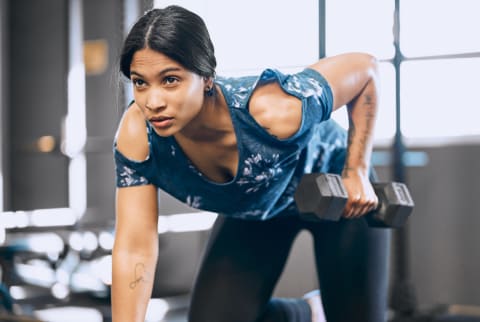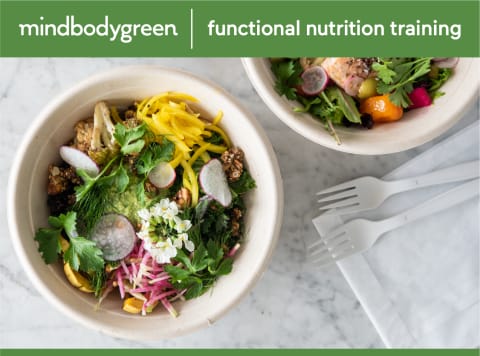Advertisement
The 4 Most Important Habits For Maintaining Bone Health & Preventing Osteoporosis


Our bones form the foundation of our bodies. But much like the foundations of a house, we don't pay them much attention until something goes wrong.
This lack of bone care has led to an uptick in osteoporosis (the condition of having weak, brittle bones) worldwide, particularly among postmenopausal women1. Ten million Americans2 over the age of 50 currently have osteoporosis, and in the UK, as many as one in two women over 503 will suffer a fracture induced by osteoporosis in their lifetime.
Once we reach a certain age, breaking a bone can be debilitating. Thankfully, there's plenty we can do in middle age to prevent osteoporosis and reduce our risk of falls and fractures down the line. "Bone is a dynamic tissue, so it's constantly being remodeled" explains registered dietitian and sports nutritionist Marie Spano, M.S., R.D.
This means that it's never a bad time to shine a light on your foundation and work to improve your skeletal health. Here are some ways to maintain a healthy reserve of bone that will carry you through life feeling strong and independent:
Eat a nutrient-rich diet
We build the most bone during our childhood and adolescence years. By the time we hit 30 or so, we've reached peak bone mass. From there, we need to make sure we're not losing more bone than we're building—and that's where nutrition becomes hugely important.
"If we don't prioritize getting bone-building nutrients, we will have a net loss of bone over time," says Spano. She explains that the three most important vitamins and minerals for bone maintenance are:
- Calcium: When it comes to skeletal health, calcium is essential. "Got Milk?" ads taught us that milk builds strong bones—but so do dark leafy greens, canned fish, beans, and other calcium-rich foods. Depending on your age, you should aim to get 1,000-1,300 mg of calcium4 each day.
- Vitamin D: "Vitamin D helps take calcium and deposit it in bone tissue," says Spano. "Most people need about 2,000 IUs of vitamin D daily to maintain adequate levels in their body, though some may need much more than that." You can find the sunshine vitamin in salmon, eggs, and other fatty fish, as well as in supplements.
- Magnesium: Magnesium is also an important mineral for bone health since it assists in the activation of vitamin D, Spano explains. Depending on your age and gender, your daily magnesium needs5 range from 310-420 mg a day. Nuts, seeds, leafy greens, and fatty fish are great sources of magnesium.
Those who didn't get proper nutrition during childhood will want to be extra diligent about getting these nutrients. But you don't need to stress too much about measuring every last milligram on your plate: Just aim to eat vegetables, fruits, whole grains, healthy fats, and proteins throughout the day.
While you're at it, do your best to eat a variety of plant foods to build the matrix of good bacteria in your gut—which has also been associated with stronger, denser bones.
Bring on the berries
Do resistance training
Like muscles, bones respond positively to time under tension. Working against a force will encourage the growth of new bone tissue, and one great stimulus is strength training6.
"If you can do 30 minutes three or four times a week of strength training, it will make such a difference," says trainer Caroline Idiens of Caroline's Circuits.
She recommends filling your sessions with simple, functional movements that you can progressively move up in weight (think: bicep curls). Bodyweight moves like squats and pushups can also provide a good stimulus for the bones, as can using lighter weights for longer rep sessions.
Idiens' one caveat: Those who already have bone discomfort or a bone disease like osteoporosis will need to be careful in the gym, as certain high-impact moves can damage bones further. You should never work through pain during a workout—there are always modifications.
She notes that outside of weight training, certain forms of cardio can also support the growth of new bone tissue. Try hiking or brisk walking on uneven terrain to give your bones the gentle impact they need to regenerate.
Make sure you're eating enough food—especially protein
Undereating is a fast track to weak, brittle bones, says Spano. She's even seen girls in their 20s who have the bones of an 80-year-old due to years of restrictive dieting.
Your bones and body need adequate amounts of macronutrients to grow strong—especially protein, since about one-third of bone mass is made up of protein7. "This is important because when we look at national survey data8, a number of females are not consuming enough protein, especially the females between 14 and 18 years of age—peak bone-building years... And then older females upward of 70 don't tend to consume enough protein—that's when we rapidly lose bone tissue," says Spano.
She recommends eating a minimum of 1.2 grams per kilogram of body weight per day; more if you're very active. Read up on what that looks like in practice here.
Focus on posture & balance
If you spend most of the day sitting, you'll want to focus on taking breaks and maintaining good posture to avoid bone issues9—particularly in the lower back.
Idiens adds that prioritizing unilateral movements that isolate one side of the body at a time can also help you build a strong, balanced musculoskeletal system. "When you do things like shoulder presses, if you're using both arms at the same time, often the strongest arm will take over. This can cause alignment issues and an imbalance of muscles. Of course, this then relates to your bones as well," she says.
If your bones can handle higher-impact moves, Idiens recommends skaters to engage your single-leg stability, balance, and bone strength all at once.
The takeaway
Spano has seen far too many older people who are scared to do their favorite activities out of fear of breaking a bone.
In this way, eating nutritious foods, getting enough protein, doing resistance training, and working on posture and balance is about so much more than your bones. It's about having the confidence to do the things you love for longer.
9 Sources
- https://pubmed.ncbi.nlm.nih.gov/27681935/
- https://www.ncbi.nlm.nih.gov/pmc/articles/PMC7115830/
- https://pubmed.ncbi.nlm.nih.gov/11728921/
- https://ods.od.nih.gov/factsheets/Calcium-HealthProfessional/
- https://www.ncbi.nlm.nih.gov/books/NBK109816/
- https://www.ncbi.nlm.nih.gov/pmc/articles/PMC6279907/
- https://www.ncbi.nlm.nih.gov/pmc/articles/PMC7155358/
- https://www.sciencedirect.com/science/article/pii/S0002916523236631
- https://www.ncbi.nlm.nih.gov/pmc/articles/PMC7664175/
